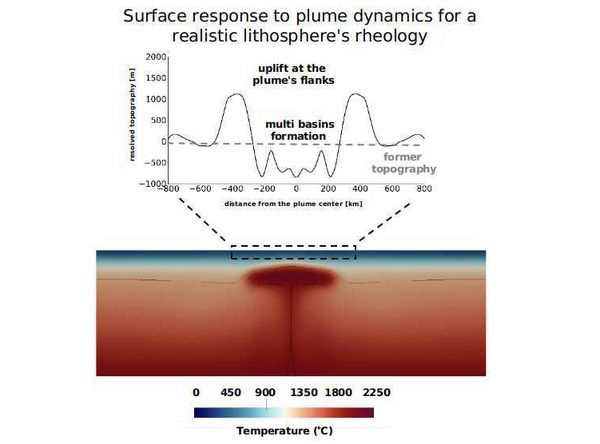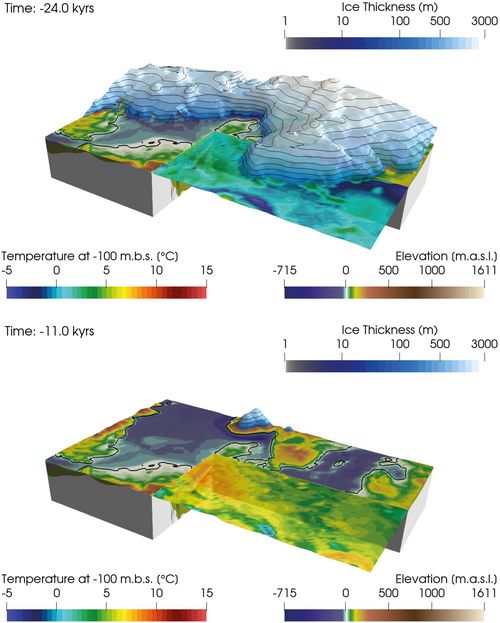ENVIRONMENT AND ENERGY
Quantitative HPC Modelling of Sedimentary Basin Systems
Principal Investigator:
Mauro Cacace
Affiliation:
Helmholtz Centre Potsdam GFZ - German Research Centre for Geosciences
Local Project ID:
MOBS
HPC Platform used:
JUWELS of JSC
Date published:
Rationale behind this study
The Earth is an extremely complex and heterogeneous dynamic system, which consists of interacting boundary layers characterized by a specific and unique behaviour due to their different tectonic histories. To translate these observations with a mathematical dictionary entails to “face a tight and stiff nonlinear and multidimensional, in terms of the resolved parameter phase space problem subjected to varying boundary and initial conditions”. Such a challenging task can only be successfully addressed by relying on sophisticated computer assisted modelling techniques in concert with the progress made in High Performance Computing (HPC) capabilities. That such an objective can be ascribed to one of the fundamental ”Great Challenges” faced by geoscientists is testified by the fact that so far there exist only few attempts that have aimed at investigating the modes of interactions across the different earth’s system compartments and the physics occurring across their interfaces. The project was envisaged within the Helmholtz funded Earth System Modelling (ESM) consortium, where efforts have been made towards improving current state of the art modelling studies of the different Earth’s systems compartments (from the deep earth to the atmosphere) and their coupling.
Project description and relevance
The focus of the project was to develop a new family of modelling kernels to resolve the complex dynamics occurring in the subsurface as responsible for the formation and evolution of our natural georesources. Attention was given to resolve the interactions thought to happen but never quantified so far between this domain and the Earth’s surface dynamics, where processes are modulated by climate dynamics as well as those happening deeper in the Earth. The main motivation of the study was therefore to arrive at a proper understanding of the behaviour of this terrestrial domain with respect to its stability in time and space when subjected to varying influence from climatic forces and the dynamics of the deep Earth. This was done in the light of the crucial role the subsurface plays for society since it hosts all of the world’s natural and mineral resources and presents the greatest hazard component for mankind.
Specific challenges
The main bottlenecks geoscientists encountered in those kind of studies can be summarized in the following: (i) complex and non linear physics across varying and diverse time and space scales that calls for increased computational demands, and (ii) a high degree of uncertainty in the model parameters due to our limited access of the subsurface.
With respect to the former aspect, we have developed scalable parallel numerical kernels to account for the multi-physic behaviour of rocks such as faulting and earthquake dynamics, thereby considering aspects that relatively few numerical models are able to account for. Main efforts have been towards increasing the flexibility of the developed physical interfaces, and to optimize the numerical setting with respect to state-of-the-art computing architectures as those provided by GCS.
With reference to the second challenge (model uncertainty) we have proposed advance modelling techniques combining physics and concept derived from Artificial Intelligence (AI). We specifically relied on Reduced Order Models that aim to construct reliable but computationally faster “replacement models” that preserve the physical processes and the main characteristics of the original problem.
Study case I: Plume-mantle-lithosphere interaction
In this application we wanted to investigate the still debated dynamics linking the deep mantle via the rigid lithosphere up to the Earth’s surface in the presence of a mantle plume. The consideration of a realistic elastic-visco-plastic lithosphere was also a novel aspect of the current study, since it has been usually neglected in companion studies. By applying the newly developed modelling techniques to this problem, as assisted by state-of-the-art HPC facilities from GCS, we have been able to capture and resolve the most important nonlinearities in the system response, resulting in a surface manifestation closer to that observed in reality as the inception of multi-basinal systems of different and superposed wavelengths in response to the resolved dynamics (see Figure 01).
Study case II. Climatic forcing, glacial cycle loading and the hydromechanical evolution of sedimentary basins
For this application, we investigated the coupling between climate forcing, including glacial cycles, to the underground thermal state, pore pressure distribution, and mechanical stability of sedimentary basins. The application aimed at investigating the influence of paleoclimate variations on the thermal and hydraulic state of the Central European Basin System (CEBS) in North and Central Europe as of interest for current subsurface exploration studies. The paleotemperature data has been simulated using the Max Planck Institute Earth System Model (MPI-ESM) considering time-dependent topographic changes and river routing while generating the set of paleoclimate temperatures.
As described above we relied on surrogate reduced models to leverage the high costs on computational resources and quantify the influence of adopted model parameters in the modelling outcome. The effects of the Fennoscandian ice dynamics during the last glacial maximum on the evolution and present-day state of the underground aquifer system have been integrated via an interface between our physical kernels to the Ice Loading module GLAC-1D developed at Memorial University of Newfoundland (Prof. Lev Tarasov). By such coupling, we have been able to demonstrate that the effect of the glacial (un)loading manifests itself at present day in the form of a resolved over-pressure distribution within the major sedimentary aquifers, thus providing an explanation to some, and still disputed observations done in the study area.
At the same time, the study provides convincing evidences on how relevant the quantification of the hydro-mechanical and associated thermal history of such complex basin systems is for a proper understanding of their present day state as well as for any forecasting activity aiming at a proper explorative quantification of the georesource potential of any underground natural system (Figure 02 and mp4-video below).
NOTE: This video is also available at https://youtu.be/1OpTqF-cS-g.
© GFZ German Research Centre for Geosciences, Potsdam
Outlook
Follow up projects will be delineated along two main routes. On the one hand, we are aiming at increasing the details in the description of the physics occurring at and across both interfaces (earth’s surface and mantle) for the dynamics of the subsurface terrestrial compartment. On the other hand, we will work on improving the efficient usage of reduced order methods for such high complex geoscientific problems by exploiting the possibility of combining these methods to machine learning approaches thereby widening the level of applications of these novel methodologies.
ISI publications
- Jacquey, A. B., and Cacace, M. (2020). Multiphysics Modeling of a brittle-ductile lithosphere: Explicit visco-elasto-plastic formulation and its nu-merical implementation. Journal of Geophysical Research: Solid Earth,125, e2019JB018474. https://doi.org/10.1029/2019JB018474
- Jacquey, A. B., and Cacace, M. (2020). Multiphysics modeling of a brittle-ductile lithosphere: Semi-brittle, semi-ductile deformation and damagerheology. Journal of Geophysical Research: Solid Earth, 125, e2019JB018475. https://doi.org/10.1029/2019JB018475
- Degen, D. and Cacace, M. (2020): Effects of Transient Processes for Thermal Simulations of theCentral European Basin. Geoscientific Model Development Discussions, pp. 1- 27.
Peer reviewed conference contributions
- Cacace, M. and Jacquey, A.B. (2019): Multiphysics of faulting: influ-ence of porosity and damage evolutions on the deformation modes withinthe lithosphere. 13th EURO-CONFERENCE ON ROCK PHYSICS AND GEOMECHANICS, THE GUGUEN CONFERENCE - 6 September 2019,Potsdam, Germany.
- Cacace, M. and Jacquey, A.B. (2020): Thermodynamic consistent formulation for the multiphysics of a brittle ductile lithosphere - semi-brittle semi-ductile deformation and damage rheology. EGU General Assembly 2020 EGU2020-13398. https://doi.org/10.5194/egusphere-egu2020-13398
- Frick, M., Cacace, M., Klemann, V., Tarasov, L., and Scheck-Wenderoth, M. (2020): The effects of glacial-interglacial loading on the 3D pore pressure evolution in sedimentary basins: case study from the Central European Basin System. EGU General Assembly 2020 EGU2020-9595. https://doi.org/10.5194/egusphere-egu2020-9595
- Jacquey, A.B., Regenauer-Lieb, K., Parisio, F., and Cacace, M. (2020): Multiphysics of transient deformation processes leading to macroscopic instabilities in geomaterials. EGU General Assembly 2020 EGU2020-16050. https://doi.org/10.5194/egusphere-egu2020-16050
Note: This project was run on the ESM (Earth System Modelling) partition of HPC system JUWELS of Jülich Supercomputing Centre.
Project Team
Dr. Mauro Cacace1 (PI), Dr. Denise Degen2, Dr. Maxmilian Frick1, Dr. Antoine B. Jacquey3
1Helmholtz Centre Potsdam GFZ - German Research Centre for Geosciences, Potsdam, Germany
2RWTH Aachen University, Aachen, Germany
3Massachusetts Institute of Technology, MIT, Cambridge, Massachusetts, USA
Scientific Contact
Dr. Mauro Cacace
Group Leader Basin Modelling
Helmholtz Centre Potsdam GFZ - German Research Centre for Geosciences, Potsdam
Telegrafenberg, D-14473 Potsdam (Germany)
e-mail: mauro.cacace [@] gfz-potsdam.de
https://www.gfz-potsdam.de/en/section/basin-modeling/overview/
Local project ID: MOBS
December 2020

